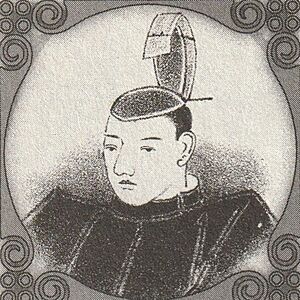Emperor Horikawa facts for kids
Quick facts for kids
|
|||||
|---|---|---|---|---|---|
 |
|||||
| Emperor of Japan | |||||
| Reign | January 3, 1087 – August 9, 1107 | ||||
| Coronation | January 16, 1087 | ||||
| Predecessor | Shirakawa | ||||
| Successor | Toba | ||||
| Born | August 8, 1079 | ||||
| Died | August 9, 1107 (aged 28) | ||||
| Burial | Nochi no Enkyō-ji no misasagi (後円教寺陵) (Kyoto) | ||||
| Spouse |
Tokushi
(m. 1093) |
||||
| Issue Among others... |
|
||||
|
|||||
| House | Yamato | ||||
| Father | Emperor Shirakawa | ||||
| Mother | Fujiwara no Kenshi | ||||
Emperor Horikawa (堀河天皇, Horikawa-tennō, August 8, 1079 – August 9, 1107) was the 73rd emperor of Japan, according to the traditional order of succession.
Horikawa's reign spanned the years from 1087 through 1107.
Biography
Before his ascension to the Chrysanthemum Throne, his personal name (imina) was Taruhito-shinnō (善仁親王). He was also known as Yoshihito-tennō.
Horikawa was the son of Emperor Shirakawa. His mother was Fujiwara no Kenshi (藤原賢子), adopted daughter of Fujiwara Morozane (藤原師実). His wet nurse was a different Fujiwara no Kenshi (藤原兼子).
Empresses, consorts, and issue
- Empress (Chūgū): Imperial Princess Tokushi (篤子内親王), Emperor Go-Sanjo’s daughter
- Consort (Nyōgo): Fujiwara no Ishi (藤原苡子; 1076-1103), Fujiwara no Sanesue’s daughter
- Imperial Prince Munehito (宗仁親王) later Emperor Toba
- Lady-in-waiting (Naishi): Princess Jinshi (仁子女王; d.1126), Prince Yasusuke’s daughter
- Imperial Princess Soshi (悰子内親王, 1099–1162)
- Lady-in-waiting (Naishi): Fujiwara Muneko (藤原宗子; d.1129), Fujiwara Takamune’s daughter
- Kangyō (寛暁; 1103–1159)
- Lady-in-waiting (Naishi): Fujiwara Tokitsune’s daughter
- Imperial Prince Priest Saiun (最雲法親王; 1105–1162) head priest of the Tendai sect
- Mother Unknown
- Imperial Princess Kishi (喜子内親王)
- Imperial Princess Kaishi (懐子内親王)
Rule
After becoming crown prince, he acceded to the throne upon the abdication of his father Emperor Shirakawa on January 3, 1087 (Ōtoku 3). His father's kampaku Fujiwara Morozane became regent, and Horikawa's reign was overshadowed by the cloistered rule of his father. Horikawa filled his reign with scholarship, poetry, and music.
When Horikawa's empress-consort Fujiwara no Ishi (藤原苡子) died in 1103, his son the Imperial Prince Munehito was taken to be raised by the retired Emperor Shirakawa. This son later succeeded Horikawa to the throne and was later known as Emperor Toba.
Horikawa died at the age of 28 on August 9, 1107 (Kajō 2). He is among the seven emperors entombed near Ryōan-ji in Kyoto. He is traditionally venerated at the Nochi no Yenkyō-ji no misasagi memorial Shinto shrine; this site has been designated as Horikawa's mausoleum by the Imperial Household Agency.
Eras
The years of Horikawa's reign are more specifically identified by more than one era name or nengō.
- Ōtoku (1084–1087)
- Kanji (1087–1094)
- Kahō (1094–1096)
- Eichō (1096–1097)
- Jōtoku (1097–1099)
- Kōwa (1099–1104)
- Chōji (1104–1106)
- Kajō (1106–1108)
Kugyō
During Horikawa's reign, the high-ranking kugyō of the imperial court included:
- Sesshō/Daijō-daijin Fujiwara Morozane (1043–1101)
- Kampaku/Nidaijin Fujiwara Moromichi (1062–1099)
- Kampaku/Udaijin/Dainagon Fujiwara Tadazane
See also
 In Spanish: Horikawa Tennō para niños
In Spanish: Horikawa Tennō para niños
- Emperor of Japan
- List of Emperors of Japan
- Imperial cult
- Emperor Go-Horikawa
| Regnal titles | ||
|---|---|---|
| Preceded by Emperor Shirakawa |
Emperor of Japan: Horikawa 1087–1107 |
Succeeded by Emperor Toba |

